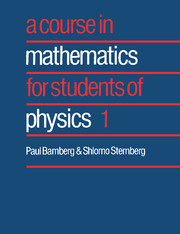Book contents
- Frontmatter
- Contents
- Contents of Volume 2
- Preface
- 1 Linear transformations of the plane
- 2 Eigenvectors and eigenvalues
- 3 Linear differential equations in the plane
- 4 Scalar products
- 5 Calculus in the plane
- 6 Theorems of the differential calculus
- 7 Differential forms and line integrals
- 8 Double integrals
- 9 Gaussian optics
- 10 Vector spaces and linear transformations
- 11 Determinants
- Further reading
- Index
Preface
Published online by Cambridge University Press: 05 August 2013
- Frontmatter
- Contents
- Contents of Volume 2
- Preface
- 1 Linear transformations of the plane
- 2 Eigenvectors and eigenvalues
- 3 Linear differential equations in the plane
- 4 Scalar products
- 5 Calculus in the plane
- 6 Theorems of the differential calculus
- 7 Differential forms and line integrals
- 8 Double integrals
- 9 Gaussian optics
- 10 Vector spaces and linear transformations
- 11 Determinants
- Further reading
- Index
Summary
This book, with apologies for the pretentious title, represents the text of a course we have been teaching at Harvard for the past eight years. The course is aimed at students with an interest in physics who have a good grounding in one-variable calculus. Some prior acquaintance with linear algebra is helpful but not necessary. Most of the students simultaneously take an intensive course in physics and so are able to integrate the material learned here with their physics education. This also is helpful but not necessary. The main topics of the course are the theory and physical application of linear algebra, and of the calculus of several variables, particularly the exterior calculus. Our pedagogical approach follows the ‘spiral method’ wherein we cover the same topic several times at increasing levels of sophistication and range of application, rather than the ‘rectilinear approach’ of strict logical order. There are, we hope, no vicious circles of logical error, but we will frequently develop a special case of a subject, and then return to it for a more general definition and setting only after a broader perspective can be achieved through the introduction of related topics. This makes some demands of patience and faith on the part of the student. But we hope that, at the end, the student is rewarded by a deeper intuitive understanding of the subject as a whole.
- Type
- Chapter
- Information
- A Course in Mathematics for Students of Physics , pp. xi - xviiiPublisher: Cambridge University PressPrint publication year: 1988

